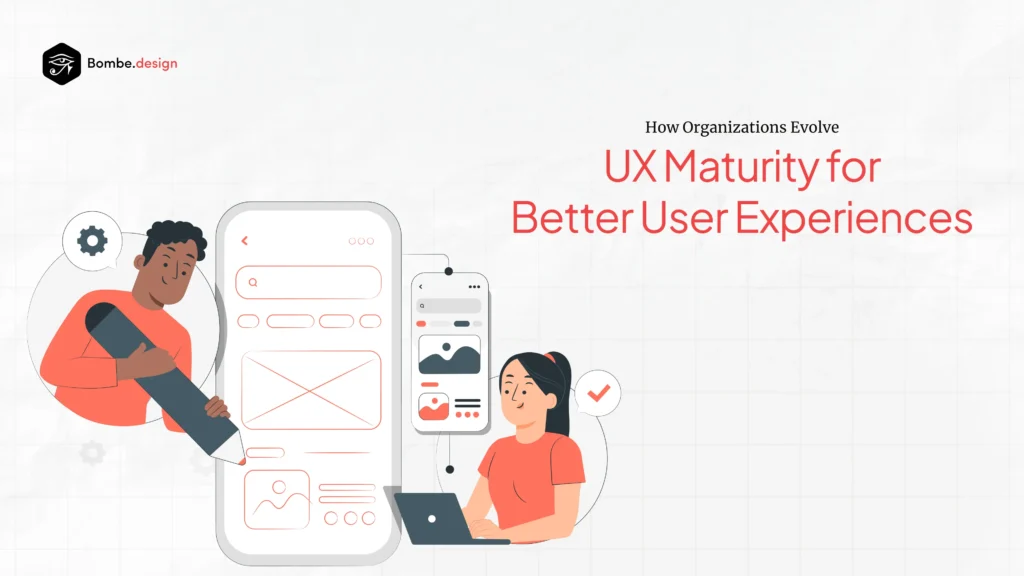User Experience (UX) maturity isn’t just about having designers on a team or running usability tests. It reflects how deeply user-centered thinking is embedded in an organization’s culture, processes, and decision-making. Organizations at higher stages of UX maturity consistently deliver products that not only function well but also delight users, creating meaningful competitive advantages.
At Bombe, we believe fostering UX maturity is key to crafting innovative, user-centric digital experiences that stand out in today’s competitive landscape.
In this blog, we’ll explore what UX maturity means, the stages organizations typically progress through, the challenges they face along the way, and strategies to evolve from basic UX awareness to innovation-driven design leadership.
What Is UX Maturity?
UX maturity refers to the level of an organisation’s capability in integrating user-centered design into its workflows. It’s not just a design discipline; it’s a cultural marker. Mature organizations recognize the ROI of UX, see it as a strategic asset, and align it across business, design, and technology.
Why UX Maturity Matters
UX maturity plays a crucial role in shaping customer trust and loyalty, as mature practices lead to seamless and reliable experiences that encourage users to return. Businesses also benefit, as organizations with higher UX maturity report better conversion rates, fewer support issues, and stronger reputations within their industries.
Teams inside such organizations experience greater alignment as cross-functional collaboration improves, with user needs serving as a shared priority across roles.
Stages of UX Maturity by Nielsen Norman Group
1. Absent
UX is virtually nonexistent or ignored. Organizations lack awareness of user-centered design, and decisions get made without considering the user. Design efforts are reactive or absent, often leading to frustrating and inconsistent experiences. The focus here is on creating awareness and educating leadership on the critical business impact of UX.
2. Limited
UX efforts are sporadic and uncoordinated. Some individuals may perform UX tasks but without a cohesive strategy or collaboration. Research is often reactive, done to troubleshoot rather than anticipate. Building a consistent UX practice and gathering organizational support is the key challenge.
3. Emergent
Organizations begin investing in dedicated UX teams and processes, although this is done inconsistently. UX activities shift towards proactivity, with early user research and iterative design. Leadership shows growing interest but may still see UX as a supporting function. The imperative is to standardize practices and embed UX thinking deeper into the product lifecycle.
4. Structured
UX practices become formalized and integrated company-wide. UX teams are involved throughout product development with consistent methodologies. Leadership recognizes UX as a strategic asset, and user research systematically informs decisions. Cross-functional collaboration grows, and UX metrics start influencing business strategy.
5. Integrated
UX is pervasive, seen as a shared responsibility rather than siloed. Continuous user feedback loops are embedded at every stage. UX strategy aligns fully with business goals, powering innovation and differentiation. Investment in UX training, tools, and resources is robust, and user needs guide all decision-making.
6. User-Driven
At the pinnacle of maturity, organizations are user-driven innovators. Users actively co-create solutions, aided by advanced research techniques like behavioral analytics and personalized experiences. UX isn’t just user-centered but ingrained in corporate DNA from executives to teams, fueling constant iteration, delight, and market leadership.
Challenges in Reaching Higher UX Maturity
Advancing through these stages is not without difficulties. Budget constraints often push UX down the priority list, while cultural resistance keeps teams tied to traditional processes. Without executive support, UX initiatives struggle to gain traction or scale.
Another barrier lies in measuring ROI; many companies fail to connect UX improvements with tangible business outcomes, which makes it harder to secure long-term investment.
How to Advance Your Organization’s UX Maturity
- Educate and advocate: Build team-wide understanding of UX’s strategic value.
- Small wins: Use pilot projects with measurable results to build momentum.
- Formalize processes: Develop repeatable, scalable UX workflows.
- Get leadership buy-in: Present data-driven cases for sustained investment.
- Foster collaboration: Align designers, engineers, marketers, and product managers around user needs.
- Invest in resources: Equip teams with design systems, research platforms, and skilled UX talent.
Case Study – Cannect
Cannect, Canada’s largest lender network, offers mortgage services across refinancing, renewals, home equity, and investments, each catering to distinct audience segments with varying demographics. To address these differences, the team designed tailored iterations of digital forms for each vertical, ensuring the workflows aligned with the needs and expectations of their respective users.
Through iterative testing and optimized UX saturation, the forms were simplified, accessible, and emotionally aligned with Cannect’s core motto, “Happy Canadian Families.” This approach not only reduced drop-offs and improved completion rates but also delivered a measurable increase in revenue, proving how advancing UX maturity from basic usability to audience-specific, emotionally resonant design can transform complex financial services into seamless, trustworthy experiences.
Future of UX Maturity
As digital ecosystems grow more complex, advanced UX maturity will shape the future of personalization, ethical AI, accessibility, and sustainability. The next wave of UX is not limited to smoother interfaces but is about creating responsible, inclusive, and human-centered experiences that respond to the challenges of tomorrow.
Check out the UX Maturity assessment by NNG group
Conclusion
The UX maturity journey is a cultural transformation, not just a checklist. Organizations grow from seeing UX as a “nice-to-have” to embracing it as a strategic innovation driver.
At Bombe, we champion continuous UX maturity growth to help businesses move from basics to industry-leading design innovation.
Where does your organization stand on its UX maturity journey?
Book a Free UX Consultation with us and learn more!

